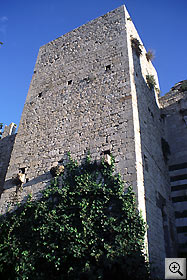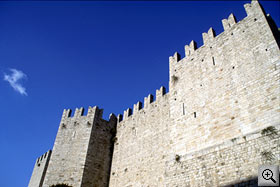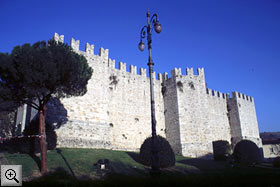Emperor's Castle of Prato
The castle rises in the historical center of the city of Prato.
» Click here for more Photos
» Take a look at some Old
Images of this castle!
» Discover the 'Cassero'
 |
| One of the precedent fortress two towers inglobate
in the new castle |
The Emperor's Castle, also known as Fortress
of S.Barbara or Castello Svevo, is considered the most important
Prato's testimony of 11-13th centuries architecture. It was the headquarters
of the Imperial party in the Florentine countryside, seat of the Imperial
Viceroy of Tuscany. The main feature of the castle is its aspect: a marvelous
example of Federician Castle like the other masterpieces that we
can find in the South of Italy, as Castel del Monte or Lagopesole, the
only in this part of the Italian peninsula.
The castle's construction begun in 1237 and ended in 1248 by order of
the Holy Roman Emperor Frederick II of Swabia, in the circle of his project
to set under military control the principal ways of communications
that brought to Germany, in detail the road that, coming down from the
Montepiano Pass (the lowest in the Apennines) crossed the Bisenzio Valley
in the heart of Tuscany. This strategical location made the castle an
important key in the plan for the new organization of the Italian Kingdom
pursued by Frederick Hohenstaufen in the years immediately after his victory
at Cortenuova (27 November 1237). This system of fortification consisting
in other castles, walled villages (like the near Calenzano) and strongholds
all in visual contact (with fire or smoke signals) with each other. At
the end of Frederick's Imperial dream the chain was consolidated by Florence,
at defense of its important trade routes.
The 'Magister Murorum' [architect] of the castle's was Riccardo da Lentini [supervisor of the construction of Emperor's other castles in Puglia] with masonry come on purpose from the south. The site of the fortress already held a small fortress, given to the Emperor from a Ghibelline family of Prato, that was incorporated in the new castle.
The castle has a square plan, with towers to all angles
and other four, two inherited by the precedent small fortress, at the
center of every side of the wall curtain. The walls and the towers are,
along the whole perimeter, crowned with the characteristic Ghibelline
battlements at 'tail of swallow'. The towers of the preexisting fortification [higher
in origin] incorporate in the construction have compromised the geometric
result of the plan, not perfect as in the other Federician castles
of southern Italy, however the symbolism of the octagon (according
to the concept of Frederick 'the maximum display of power') was
achieved: the castle has eight towers.
The main gate, a doorway with gothic arch, is embellished - and here we
notice as the Norman style suffered the local architectural influence
- with decorative elements obtained alternating stripes of white and green
marble. The sculptured lions (symbol of Swabia) are a representation of
the Imperial power. We can also notice the accurate study on the positioning
of the loopholes to allow the front and the side defense. The image of
the castle results a perfect fusion between style and military function.

|
| Plan of the Castle |
Emperor's death (1250) brought works to an halt. The inner courtyard of the castle doesn't preserve traces of the never completed two floors buildings with arcade supported by a row of columns with capitols (some still visible on the walls). In place of this projected structure were built wooden barracks to house the military contingent. Until the recent restorations the inner ward was occupied with modern structures, for long time the castle was used as county jail. Some buildings raised against the external walls, today fortunately completely removed.
The historical center of Prato is rich of medieval monuments as the Cathedral or the Praetorian Palace, but it is important to remember that the city still preserves wide portions of the town walls, visible in more parts even if not more practicable along the watch-walk. The structure that conneceted the castle to the walls was the Cassero »
| More Photos |
| Back to Homepage |
| Back to Castles Index |

